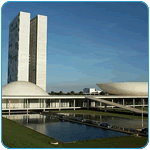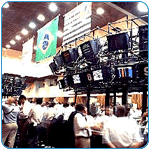 Brazilian Stock Market: Rio de Janeiro Stock Exchange
Brazilian Stock Market: Rio de Janeiro Stock Exchange
Historical Notes (continued)
Decline and Fall of the Rio de Janeiro Stock Exchange
Decline and Fall of the Rio de Janeiro Exchange : Prior to 1971, the Rio de Janeiro Stock Exchange still had a chance of keeping its crown as the leading Brazilian stock exchange. Generally, a stock exchange that has the largest trading volume can maintain its leadership position indefinitely, unless it fails to keep up with the needs of the market. Prior to 1964, all Brazilian stock exchanges were controlled by a small number of official brokers who had passed on exclusive privileges from father to son since the days of the Empire. However, the Revolution of 1964 broke this oligarchy and introduced reforms to the securities markets. Immediately after the Revolution of 1964, the Rio de Janeiro Stock Exchange had the following advantages:
The challenges that the Rio Exchange faced were as follows:
 The removal of the seat of government to Brasilia was a blow from which Rio de Janeiro never recovered. The removal of the seat of government to Brasilia was a blow from which Rio de Janeiro never recovered.Nevertheless, the Rio Exchange still had a chance in 1965 if they could modernize fast enough and use their position to continue to dominate the secondary market. The modernization plan of 1965 called upon brokers to work together and set up centralized back-office and communications facilities that would allow them to compete effectively with the largest banks. As it turned out, the São Paulo Exchange was slow to modernize, giving the Rio Exchange time to consolidate its position as leader in trading volume. If the Rio brokers had acted while Octávio Bulhões, Dénio Nogueira, and Garrido Torres were still in power, it is probable that the Rio Exchange could have obtained financing for modernization from the National Economic Development Bank. Unfortunately for the future of the Rio Exchange, its management was not up to the task and by 1967, when Delfim Netto became minister of finance, the São Paulo banking interests held the winning cards.
In the case of S-N Investimentos, a new broker under the reform law and closely associated with the modernization plan, M. Marcello Leite Barbosa invited the entire sales force of this company to a party at his home and informed them that S-N Investimentos would never be allowed to become a member of the exchange. He then offered the salesmen double what they were earning at S-N Investimentos and promised each a private office and secretary if they joined his firm. He was successful in hiring away the new company's sales force. S-N Investimentos was forced to recruit and train a new salesforce. It took direct intervention from the Minister of Finance Bulhões to stop Marcelo Leite's schemes. In any event, in 1972 São Paulo became the first Brazilian exchange to install electronic systems. The decade-long decline in stock prices following the boom of 1971 was a set-back for Rio brokers who were dependent upon individual investors and who were not associated with the new 'investment banks'. In 1990, following the example of Taiwan, Bangkok, and other emerging markets, the São Paulo Bolsa installed the CATS electronic trading system donated by the Toronto Stock Exchange. By the last decade of the century, the Rio Exchange had fallen so far behind São Paulo that recovery was no longer possible. Having failed to modernize and establish sound back office procedures, the Rio Exchange became increasingly vulnerable to a failure of its clearing house as the market expanded with the entry of foreign investors.  By the 1980s, the São Paulo Exchange dominated the Brazilian market. By the 1980s, the São Paulo Exchange dominated the Brazilian market.In 1989, a wealthly speculator, Naji Nahas, presented a bad check for over $10 million in settlement of a trade on the Rio Exchange. Due to sloppy internal controls and lack of credit discipline, the Rio de Janeiro clearing house failed, with repercussions that wiped out the capital of member firms. Descendants of some of the same official brokers who had refused to modernize in 1965, were caught up in the criminal proceedings that followed. The political and financial scandal was of such magnitude the Rio de Janeiro Stock Exchange never recovered and was forced to close its doors, merging its meager assets with the now dominant São Paulo Exchange. |

